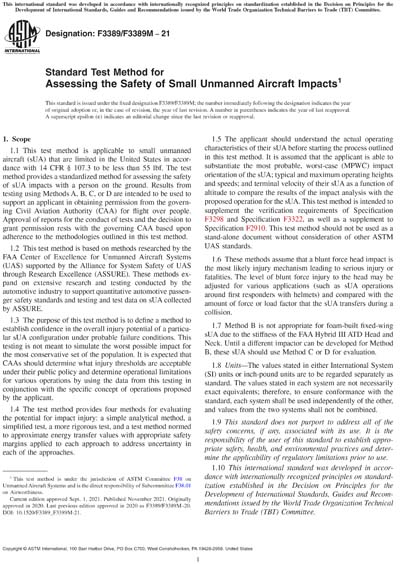Most recent
ASTM F3389/F3389M-21
Standard Test Method for Assessing the Safety of Small Unmanned Aircraft Impacts
1.1This test method is applicable to small unmanned aircraft (sUA) that are limited in the United States in accordance with 14 CFR § 107.3 to be less than 55 lbf. The test method provides a standardized method for assessing the safety of sUA impacts with a person on the ground. Results from testing using Methods A, B, C, or D are intended to be used to support an applicant in obtaining permission from the governing Civil Aviation Authority (CAA) for flight over people. Approval of reports for the conduct of tests and the decision to grant permission rests with the governing CAA based upon adherence to the methodologies outlined in this test method.
1.2This test method is based on methods researched by the FAA Center of Excellence for Unmanned Aircraft Systems (UAS) supported by the Alliance for System Safety of UAS through Research Excellence (ASSURE). These methods expand on extensive research and testing conducted by the automotive industry to support quantitative automotive passenger safety standards and testing and test data on sUA collected by ASSURE.
1.3The purpose of this test method is to define a method to establish confidence in the overall injury potential of a particular sUA configuration under probable failure conditions. This testing is not meant to simulate the worst possible impact for the most conservative set of the population. It is expected that CAAs should determine what injury thresholds are acceptable under their public policy and determine operational limitations for various operations by using the data from this testing in conjunction with the specific concept of operations proposed by the applicant.
1.4The test method provides four methods for evaluating the potential for impact injury: a simple analytical method, a simplified test, a more rigorous test, and a test method normed to approximate energy transfer values with appropriate safety margins applied to each approach to address uncertainty in each of the approaches.
1.5The applicant should understand the actual operating characteristics of their sUA before starting the process outlined in this test method. It is assumed that the applicant is able to substantiate the most probable, worst-case (MPWC) impact orientation of the sUA; typical and maximum operating heights and speeds; and terminal velocity of their sUA as a function of altitude to compare the results of the impact analysis with the proposed operation for the sUA. This test method is intended to supplement the verification requirements of Specification F3298 and Specification F3322, as well as a supplement to Specification F2910. This test method should not be used as a stand-alone document without consideration of other ASTM UAS standards.
1.6These methods assume that a blunt force head impact is the most likely injury mechanism leading to serious injury or fatalities. The level of blunt force injury to the head may be adjusted for various applications (such as sUA operations around first responders with helmets) and compared with the amount of force or load factor that the sUA transfers during a collision.
1.7Method B is not appropriate for foam-built fixed-wing sUA due to the stiffness of the FAA Hybrid III ATD Head and Neck. Until a different impactor can be developed for Method B, these sUA should use Method C or D for evaluation.
1.8Units - The values stated in either International System (SI) units or inch-pound units are to be regarded separately as standard. The values stated in each system are not necessarily exact equivalents; therefore, to ensure conformance with the standard, each system shall be used independently of the other, and values from the two systems shall not be combined.
1.9This standard does not purport to address all of the safety concerns, if any, associated with its use. It is the responsibility of the user of this standard to establish appropriate safety, health, and environmental practices and determine the applicability of regulatory limitations prior to use.
1.10This international standard was developed in accordance with internationally recognized principles on standardization established in the Decision on Principles for the Development of International Standards, Guides and Recommendations issued by the World Trade Organization Technical Barriers to Trade (TBT) Committee.
Content Provider
ASTM International [astm]






